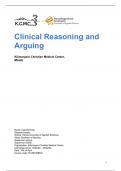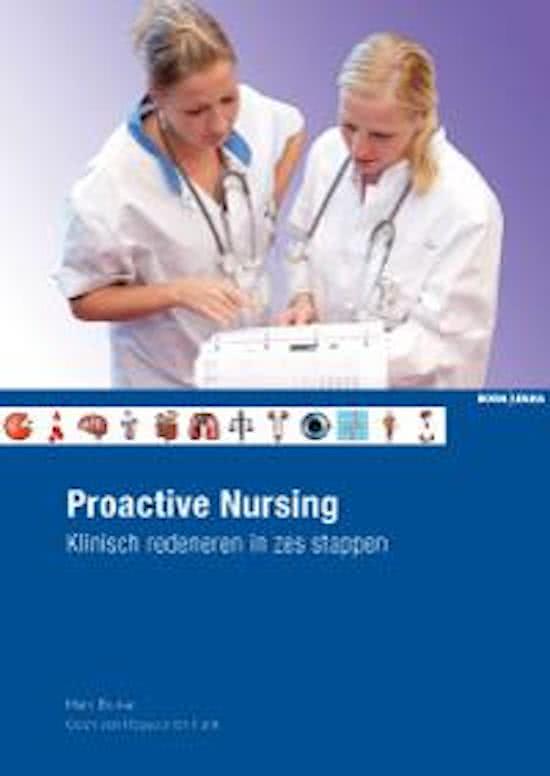Clinical Reasoning and
Arguing
Kilimanjaro Christian Medical Center,
Moshi
Name: Inge Demmer
Student number:
School: Hanze University of Applied Sciences
Study: Bachelor of Nursing
Supervisor school:
Supervisor KCMC:
Organization: Kilimanjaro Christian Medical Centre
Internship period: 12/02/24 – 05/02/24
Date: 19th of April
Course code: HVVB21MBVZ
1
,Table of contents
Introduction 4
Chapter 1; Case introduction 6
Chapter 2; Orientation to the situation 7
2.1 SBAR 7
2.1.1 Situation 7
2.1.2 Background 7
2.1.3 Assessment 8
2.1.4 Recommendation 11
Chapter 3; Understanding clinical problems 13
3.1 Care topics 13
3.2 Conclusions Care topics 16
4.1 Physical Examination 18
4.2 Imaging examination 18
4.3 Blood investigation 19
4.3.1 Blood analysis 19
4.3.1 Bloodgas analysis 19
4.4 Conlusie aanvullend onderzoek 20
4.5 Anamnesis 20
4.6 Ecogram 22
4.7 Self-reliance radar 23
Chapter 5; Clinical policy 26
5.1 Nursing diagnosis 26
5.2 prioritizing of diagnoses 29
5.2.1 Verantwoording van de diagnoses 30
5.3 Planning of care results and interventions 31
5.3.1 Impaired spontaneous ventilation 31
5.3.2 IneEective infant feeding pattern 32
5.3.3 Risk for shock 34
5.3.4 Risk for imbalanced body temperature 35
5.4 Het uiteindelijke ziekteverloop 36
Chapter 6; Clinical course 37
6.1 Desired course 37
6.2 Undesired course 37
Chapter 7; Review 38
7.1 Patient safety 38
7.2 Quality of professional practice 38
7.3 Ethical dilemma 39
7.4 Learning points 40
2
,Chapter 8; Information- and communication technology 41
8.1 distractions during handling 41
8.2 Communication 41
8.2.1 Shared discission making 42
Chapter 9; Case report 43
9.1 SBAR 43
9.3 Diagnoses and interventions 44
9.4 Conclusion 46
Appendix A: Complexity of the case 53
Appendix B: Normal ranges for vital signs KCMC 56
Appendix C: Screening stool for raspatory insuViciencies 57
Appendix D: Anti-plagiarism statement 58
3
, Introduction
This assignment is written by an HBO-v intern from Hanze University of Applied Sciences,
Groningen. The intern is doing her PLP3 internship at the Kilimanjaro Christian Medical Centre
(KCMC) in Moshi, Tanzania.
The intern is doing her internship in the pediatrics department. This is a department that focuses
entirely on children from neonatal to recovery from surgical procedures. Within the pediatrics
department, children lie for both low complex care and high complex care. Typically, the
department is home to many different disease states (Stichting kind en Ziekenhuis, 2020).
The module arguing care will be covered in this assignment. Through clinical reasoning, the
intern demonstrates responsibility for the nursing process of a highly complex case within the
department. The six steps of Bakker for clinical reasoning were chosen to provide a clear
structure for case reasoning (Bakker & Van Heycop ten Ham, 2014).
Within the module, three Canmeds roles come out strongly. These are the roles: the caregiver,
the communicator, and the reflective Evidence-Based Practice (EBP) professional. The role of
the caregiver revolves around being knowledgeable about the clinical picture and the entire care
process involved. There will also be a focus on the self-efficacy of the case. While providing care
to the case, the intern performed the role of communicator. By communicating professionally,
listening attentively, and empathizing with the situation of the case. Through clear and good
communication, gathering information went smoothly and it was possible to see exactly where
the need was in terms of care. Finally, the intern played the role of an EBP professional by using
protocols, guidelines, and various methodologies. Also, promoting their expertise and reflecting
on it is in line with this role.
Several learning outcomes will be worked on within the module. The following learning
outcomes will be addressed:
à The student demonstrates the ability to gather and combine information from various
sources in the different phases of the nursing process within an authentic highly complex
context.
à The student establishes the nursing process based on clinical reasoning within an authentic
high-complexity situation
à Using EBP, the student accounts for the nursing process within an authentic high-complexity
context.
à The student performs the nursing process independently and evaluates the nursing process
within an authentic high-complexity context.
à The student communicates in a person-centered and professional manner with the care
recipient and their informal network, ensuring optimal information exchange.
à The student applies information and communication technologies to complement personal
contact with the caregiver and his/her informal network.
The above learning outcomes are processed within the various chapters of the module.
To guide this module, the six steps of proactive nursing are worked out. Proactive nursing is a
method of Bakker (2021) Bakker was chosen because it provides a clear guide to learning clinical
reasoning. Different ICF care themes are used. Based on the care themes, it is possible to make
connections between different problems. Through these connections, the problems are made
more understandable which makes it easier to draw up a care plan (Bakker 2021).
The first chapter will introduce the case study and describe how information gathering of the
case was accomplished. The justification for the complexity of care can be found in Appendix A.
Chapter 2 elaborates on the first step of clinical reasoning, the case will be described in detail
using the Situation, Background, Assessment, Recommendation (SBAR method) also different
reasoning tools will be used. Then, in Chapter 3, the current issues of the case are clarified using
4





